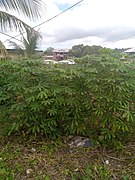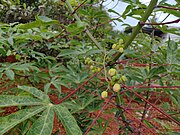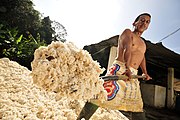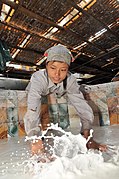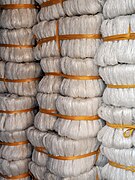Manihot esculenta
- Wɔatwerɛ nsɛm wei ɛwɔ Asante kasa mu
| subclass of | food ingredient, useful plant, poisonous plant |
|---|---|
| has use | fodder, medicinal plant, vegetable |
| short name | M. esculenta |
| taxon name | Manihot esculenta |
| taxon rank | species |
| parent taxon | Manihot |
| taxon common name | maniok |
| has fruit type | capsule |
| this taxon is source of | cassava root, tapioca, Oloyti |
| country of origin | South America |
| maintained by WikiProject | WikiProject Invasion Biology |
| hardiness of plant | 10 |
| taxon range | Fujian, Tibet Autonomous Region, Guangdong |
| taxon author citation | Crantz |
| GRIN URL | https://npgsweb.ars-grin.gov/gringlobal/taxonomydetail.aspx?id=431678 |
| sequenced genome URL | https://plants.ensembl.org/Manihot_esculenta |
Bold text'''Manihot esculenta, a ɛwɔ edin cassava, manioc, anaa yuca wɔ aman ahodoɔ so ne kasa ahodoɔ mu no yɛ aduadeɛ bi a ɛka spurge nnua abusuakuo no ho. Woba Akan kasa mu a, yɛfrɛ no bankye. Baabi a wɔnim sɛ epue firii kane ne America anaafoɔ fam. Aman bi te sɛ Brazil, Paraguay ne Andes fa baabi so na yɛgye di sɛ epue firii kane. Bankye yɛ aduane a ɛbɔ wɔ fam deɛ, nanso, ɛpɛ awia. Baabi awia bɔ na nsuo nso taa tɔ na bankye tumi yɛ yie pa ara. Ɛmpɛ baabi a ɛyɛ nwunu pii, sɛ ebia, baabi a asukɔkyea wɔ. Ɛyɛ aduane a ɛbɔ wɔ fam. Wɔnoa ansa na wɔatumi adi. Wɔtumi nso de yɛ aman( starch) bi a wɔfrɛ no tapioca tapioca. Wokɔ baabi a, Tapioca yɛ aduane dehyeɛ. Wɔtumi de yɛ gari nso wɔ Africa atɔeɛ fam. Nyɛ Africa nko; Brazilifoɔ nso tumi de yɛ gari. Wiase nnuane a ɛma carbohydrate no, bankye tɔ so mmeɛnsa.
Ne Bɔberɛ
[sesa]Bankye yɛ aduane a ɛbɔ wɔ fam. N'aduane no wowa a ebiara tuatua ne nhini so. Ne hono ahosuo no te sɛ bayerɛ. Emu aduane no yɛ fitaa.[1] Nnuane nnuro a yɛfrɛ no protiens wɔ bankye nhini no mu.[2] Mmom, methionine ne amino acid a ɛwɔ mu no sua.[3]
-
Cassava plant
-
Unprocessed tubers
-
Tuber in cross-section
-
Leaf
-
Leaf detail
-
Flower buds
-
Seeds
Cultivation
[sesa]Nneɛma ɛboa ma bankye dua wɔ nkan ne: sɛ.nsuo bɛtɔ kakra na awia nso bɛbɔ kakra. Ɛsɛ sɛ wiemuhyeɛ no gyina( 20 and 29 °C (68 and 84 °F). Sɛ wɔdua, enni mmoro nna ahanu ne aduanan na abɔ. Saa berɛ no duru na wɔntu a, bankye no bi wɔ hɔ a, ɛbɛsɛe.[4][5][6] Baabi a wɔbɛnya saa wiemuhyeɛ a ɛboa Bankye nyini no ne Gulf Coastal Plain sɛ ebia Mexico.[4] Saa nsaase a ɛboa bankye nyini wowɔ saa nneɛma ɛdidi soɔ yi; phaeozem, regosol, arenosol, andosol and luvisol.[4]
-
Stakes
Ne twa
[sesa]Ansa na wɔbɛtutu aduane a ɛhyɛ fam no, wɔdi kan twitwa ansa na nnua.[5]
-
Starch processing
-
Starch flour
-
Starch wet-processing
-
Spreading Casabe burrero (cassava bread) to dry, Venezuela
-
Starch being prepared for packaging
-
Starch noodles packaged for shipping
-
Frozen leaves in a Los Angeles market
-
Picked buds
Beaeɛ a Menyaa Mmoa Firiiɛ
[sesa]- ↑ "Basic Report: 11134, Cassava, raw". National Nutrient Database for Standard Reference Release 28. Agricultural Research Service, US Department of Agriculture. May 2016. Archived from the original on 12 July 2017. Retrieved 7 December 2016.
- ↑ Latif, Sajid; Müller, Joachim (2015). "Potential of cassava leaves in human nutrition: a review". Trends in Food Science & Technology. 44 (2): 147–158. doi:10.1016/j.tifs.2015.04.006.
- ↑ Ravindran, Velmerugu (1992). "Preparation of cassava leaf products and their use as animal feeds" (PDF). FAO Animal Production and Health Paper (95): 111–125. Archived from the original (PDF) on 15 January 2012. Retrieved 13 August 2010.
- ↑ 4.0 4.1 4.2 Del-Rosario-Arellano, José Luis; Aguilar-Rivera, Noe; Leyva-Ovalle, Otto Raúl; Andres-Meza, Pablo; Meneses-Marquez, Isaac; Bolio-López, Gloria Ivette (2022). "Zonificación edafoclimatica de la yuca (Manihot esculenta Crantz) para la producción sostenible de bioproductos" [Edaphoclimatic zoning of cassava (manihot esculenta crantz) for sustainable production of bioproducts]. Norte Grande Geography Journal (in Spanish) (81): 361–383. doi:10.4067/S0718-34022022000100361. eISSN 0718-3402. S2CID 249657496.
- ↑ 5.0 5.1 Howeler, Reinhardt H. (2007). "Production techniques for sustainable cassava production in Asia" (PDF). Centro Internacional de Agricultura Tropical (CIAT), Bangkok. Archived from the original (PDF) on 5 October 2016. Retrieved 3 May 2016.
- ↑ Willy H. Verheye, ed. (2010). "Tropical Root and Tuber Crops". Soils, Plant Growth and Crop Production Volume II. EOLSS Publishers. p. 273. ISBN 978-1-84826-368-0. Archived from the original on 11 May 2021. Retrieved 29 December 2020.
- ↑ Zidenga, T; et al. (2012). "Extending cassava root shelf life via reduction of reactive oxygen species production". Plant Physiology. 159 (4): 1396–1407. doi:10.1104/pp.112.200345. PMC 3425186. PMID 22711743.
- ↑ "Storage and processing of roots and tubers in the tropics". U.N. Food and Agriculture Organization. Archived from the original on 22 April 2016. Retrieved 4 May 2016.
- ↑ 9.0 9.1 Venturini, M. T; Santos, L. R; Vildoso, C. I; Santos, V. S; Oliveira, E. J (2016). "Variation in cassava germplasm for tolerance to post-harvest physiological deterioration". Genetics and Molecular Research. 15 (2). doi:10.4238/gmr.15027818. PMID 27173317.
- ↑ Morante, N.; Sanchez, T.; Ceballos, H.; Calle, F.; Pérez, J. C.; Egesi, C.; Cuambe, C. E.; Escobar, A. F.; Ortiz, D.; Chavez, A. L.; Fregene, M. (2010). "Tolerance to Postharvest Physiological Deterioration in Cassava Roots". Crop Science. 50 (4): 1333–1338. doi:10.2135/cropsci2009.11.0666.

